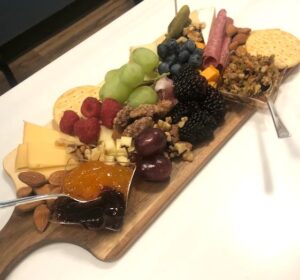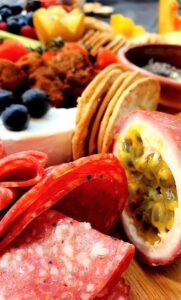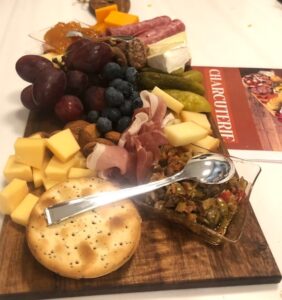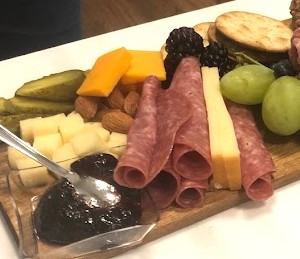 If you paused for a moment trying to determine the best pronunciation for charcuterie, you’re not alone. It is pronounced SHAAR-KOO-TREE. Outside of saying it correctly, you may also be wondering how to best select ingredients, arrange and present. Or you might be wondering how long you should leave it out for guests (or yourself). The good news is, unlike remembering how to say it, charcuterie is incredibly easy to do well! During the holidays especially, having attractive foods to meet every palate and walk-by muncher at the dinner table is important.
If you paused for a moment trying to determine the best pronunciation for charcuterie, you’re not alone. It is pronounced SHAAR-KOO-TREE. Outside of saying it correctly, you may also be wondering how to best select ingredients, arrange and present. Or you might be wondering how long you should leave it out for guests (or yourself). The good news is, unlike remembering how to say it, charcuterie is incredibly easy to do well! During the holidays especially, having attractive foods to meet every palate and walk-by muncher at the dinner table is important.
What is Charcuterie
 Charcuterie is most commonly traced back to France in the 15th Century. Translated, it roughly mean chair or char (meat) and cuite (cooked). Funnily enough, the modern use of charcuterie actually translates to “cold cuts”! For the most part, the meat historically used was different cuts of cured pork—which meant pork that had been salted to remove bacteria-loving moisture. Some cured meats, like bacon, need to still be cooked for safe consumption, and meats like prosciutto that are cured well don’t need to be. Charcuterie was a delicious way to use fermentation to slow or alter bacterial growth in meats and cheeses, elongating the protein life and use far beyond that of fresh cuts.
Charcuterie is most commonly traced back to France in the 15th Century. Translated, it roughly mean chair or char (meat) and cuite (cooked). Funnily enough, the modern use of charcuterie actually translates to “cold cuts”! For the most part, the meat historically used was different cuts of cured pork—which meant pork that had been salted to remove bacteria-loving moisture. Some cured meats, like bacon, need to still be cooked for safe consumption, and meats like prosciutto that are cured well don’t need to be. Charcuterie was a delicious way to use fermentation to slow or alter bacterial growth in meats and cheeses, elongating the protein life and use far beyond that of fresh cuts.
Presentation
 Charcuterie is typically presented on a wooden base or board—often a simple wooden cutting board is a simple and elegant way to arrange your bite-size morsels. There are a few tips and tricks to creating a visually appealing and healthy spread, whether it’s only for one or two or scaled up for many. For the holidays, consider including culturally and/or diet–specific elements. For example, swapping out pork cuts for other cured meats, including seasonal varieties of fruit, or even making a fully vegetarian board are all doable.
Charcuterie is typically presented on a wooden base or board—often a simple wooden cutting board is a simple and elegant way to arrange your bite-size morsels. There are a few tips and tricks to creating a visually appealing and healthy spread, whether it’s only for one or two or scaled up for many. For the holidays, consider including culturally and/or diet–specific elements. For example, swapping out pork cuts for other cured meats, including seasonal varieties of fruit, or even making a fully vegetarian board are all doable.
How to tips:
Preparations
- Food safety when serving others includes many considerations, but hand washing is the most important.
- Wash food contact surfaces with soap and water before preparing.
- Clean, sanitize and air dry the board prior to preparation.
- Gather all your foods and board or display trays prior to assembling the charcuterie board.
Board
- Choose your board! For 1-2 people, 6” x 17” boards (or close to that) work well. For larger groups, consider increasing the board size commensurately.
- Remember that if you’re serving more than 6-7 people, you may need to increase the variety of options on the board.
Proportions
- Typically, you can follow a 3-3-3-3 rule. That means three kinds of cheeses, three types of meat, three starches, and three accompaniments. This could look like…
- Cheddar, brie, and asiago
- Prosciutto, hard salami, and pancetta
- Mini toast crackers, pita, and sliced baguette
- Marmalade, olives, nuts
Cheese
- When selecting cheeses, remember that texture plays a big role. Choose a combination of soft, hard, and medium cheeses that can be cut differently. Brie and Gouda often comes in rounds with rinds or wax, so cutting these into attractive triangular pieces creates a stunning look.
- Cheese has a long history and enormous variety. You can learn a lot by looking at the CSU Food Source Info page that’s all about its consumption, creation, and food safe practices!
Meats
- Roll your salami or larger, thinner meat cuts into attractive shapes. A short tutorial of creating fancy charcuterie meat displays can be helpful in really increasing the beauty of your display. They are simple and create a huge WOW factor!
- Place them near your cheeses in a way that makes them easy to grab with hungry fingers.
Arrangement
- When arranging items on the board, start with height first. This means selecting a few small dishes, like ramekins or even dipping sauce bowls.
- You don’t have to get crazy fancy! Small dishes and interesting little containers create dimension and height on your board.
- After you’ve placed your ramekins/small dishes and filled them with your choice of olives (or tapenade!), marmalade, or preserves, slice and arrange your cheeses around the board.
- Group a single type of cheese in either cubes or triangular “pie” slices around the board. There will be gaps—that’s good! You’ll fill them in later.
Accessories
- Add charcuterie “accessories” to fill in the gaps and create visual appeal.
- These are your nuts (walnuts, almonds, and pecans are wonderful choices), as well as dried fruits or even fresh ones—as long as the moisture content doesn’t bleed over into your softer cheeses.
- Strawberries are delicious additions to the board, but when sliced are very moist. Try using smaller, whole strawberries, or switching to a less “wet” fruit like blueberries, grapes or apple slices (brushed with lemon juice).
Healthy upgrades:
For a healthier take on the charcuterie board, consider swapping out two starches for more varieties of nuts. You could reduce sugar by switching the marmalade for fresh fruit. This provides a burst of color on the board while still providing natural sweetness.
Food Safety
 While your cured meats remain good longer than fresh cuts, almost all food is in the danger zone if not kept below 40 degrees Fahrenheit. Wrap and refrigerate any unconsumed charcuterie before the two hour mark. To learn more about food safety, visit CSU Extension’s Nutrition, Food Safety, & Health website to read publications, recent updates to food safety practices, and other nutritional information.
While your cured meats remain good longer than fresh cuts, almost all food is in the danger zone if not kept below 40 degrees Fahrenheit. Wrap and refrigerate any unconsumed charcuterie before the two hour mark. To learn more about food safety, visit CSU Extension’s Nutrition, Food Safety, & Health website to read publications, recent updates to food safety practices, and other nutritional information.
Charcuterie is a wonderful (and fancy!) way to put a lot of excellent protein into events and holidays. Your ability to augment each board to your own dietary wants and needs provides ample opportunity to create nutritious and even unusual combinations to celebrate what we all know and love: being together for the holidays, and sharing delicious food.

